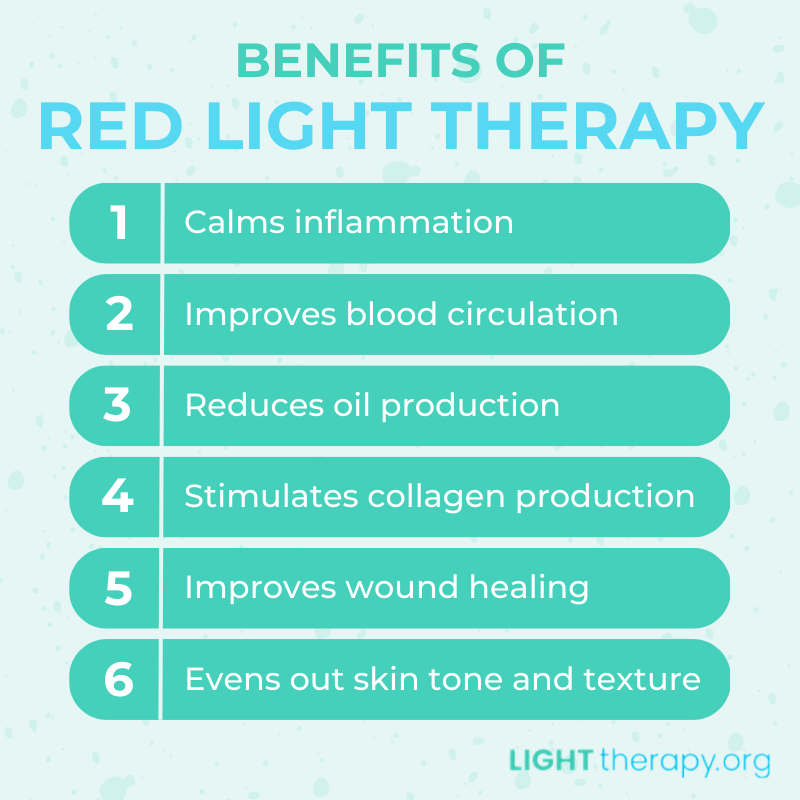Blue and Red Light Therapy for Acne: Why You Need Both
When you mix blue and red, what do you get? Purple, right?
Actually, what you could get is clear, radiant skin — if the blue and red are coming from a light therapy device.
Blue and red light therapy for acne is a treatment option that’s been gaining speed in recent years. It’s a clinically proven way to heal existing acne and prevent new breakouts.
Interested in this innovative treatment? Keep scrolling!
Light Therapy for Acne
Acne can form anywhere on your body that oil-producing glands exist, which is everywhere except the palms of your hands and the soles of your feet.
These glands are responsible for keeping your skin hydrated, but when they produce too much oil, called sebum, a dermatological disaster can follow. Excess sebum gets trapped in the pores of your skin, and when dead skin cells, dirt, and debris join the mix, the pores clog.
Enter Propionibacterium acnes, or P. acnes, the bacteria responsible for acne breakouts. When P. acnes gets into a clogged pore, the bacteria proliferate to cause an infection. Now you have a full-blown breakout on your hands! Your immune system sends white blood cells to the area to fight the infection, causing the visible redness and inflammation that make us so self-conscious.
But fear not! Fighting acne is one of the primary — and most researched — applications of light therapy. If you’re fighting a mild-to-moderate breakout, blue and red light therapy for acne could be the safe, non-invasive treatment you’re looking for.
When it comes to conquering acne, blue and red wavelengths of light each have their own unique benefits. Together, they work to reduce inflammation, eliminate P. acnes, soothe damaged skin, and promote faster recovery.
Hundreds of studies have proven the positive effects of blue and red light therapy for acne, and researchers have concluded that light therapy has few to no adverse side effects.
Participants in a 2008 study saw a nearly 70% reduction in inflammatory acne after using an at-home device for just four weeks. A similar study conducted in 2013 found a 54% reduction in non-inflammatory acne and a 77% reduction in inflammatory acne.
Why You Need Blue Light
Blue light is an essential part of light therapy for acne.
Its antimicrobial properties destroy P. acnes through a process called photoexcitation. The energy from the blue light infiltrates the acne-causing bacteria and excites the molecules. This excitement generates a reactive oxygen species (ROS) that breaks down and destroys the bacterial cells.
Once the bacteria within a pimple die, healing becomes much easier. The immune system no longer has to fight that infection, and the associated inflammation and redness start to diminish. Plus, reducing P. acnes on the skin helps prevent future acne from developing.
Blue light therapy also helps reduce oil production — making clogged pores much less likely.

Why You Need Red Light
With the bacteria destroyed, the stage is set for red light therapy to make its impact.
Red light is not antimicrobial, so it doesn’t destroy bacteria, but it has many other benefits for acne sufferers.
Here are six helpful effects of red light therapy for acne-prone skin:
- Calms inflammation
- Improves blood circulation
- Reduces oil production
- Stimulates collagen production
- Improves wound healing
- Evens out skin tone and texture
All these benefits work together to heal acne blemishes more quickly, leaving skin rejuvenated and healthy. They may also improve the appearance of existing acne wrinkles and scars left by previous breakouts.
A big bonus of using red light therapy to treat acne is its well-known anti-aging activity. Increased collagen production and blood circulation plump up the skin, reducing wrinkles and fine lines. Red light can also diminish age spots and sun damage while boosting elasticity and firmness, leaving skin rejuvenated and bright.
Blue and Red Light Therapy for Acne: Final Thoughts
According to the American Academy of Dermatology, people with persistent acne are more likely to develop symptoms of anxiety and depression than those with clear skin. These are debilitating mental health conditions, which is why it’s so important to continue developing innovative treatments that can effectively treat acne — without unpleasant or risky side effects.
Today, blue and red light therapy for acne is an excellent option. Light therapy clinics are available, but at-home devices are also a sound and reasonable choice. These devices range from just under $100 all the way up to thousands of dollars.
Depending on your skincare needs and how much you want to invest, the right choice for you is likely somewhere in the middle. For example, the clinically backed Luminance RED – ClearBeam Acne Device costs $499 and comes with a six-month, 100% money-back guarantee and flexible finance options.
Our advice? Consider products that feature both blue and red light therapy for acne, read reviews carefully, and be selective about the company you purchase from. Light therapy can help you achieve your skincare goals — but only if the device you choose works!